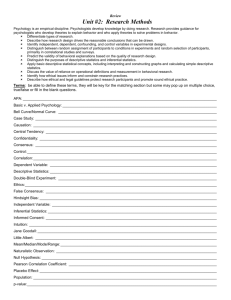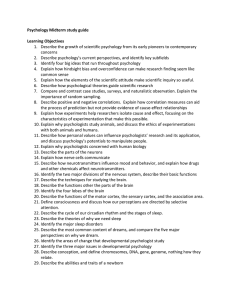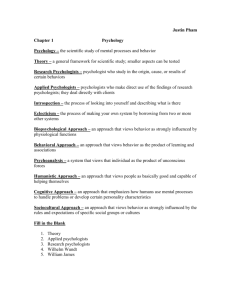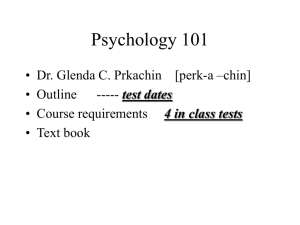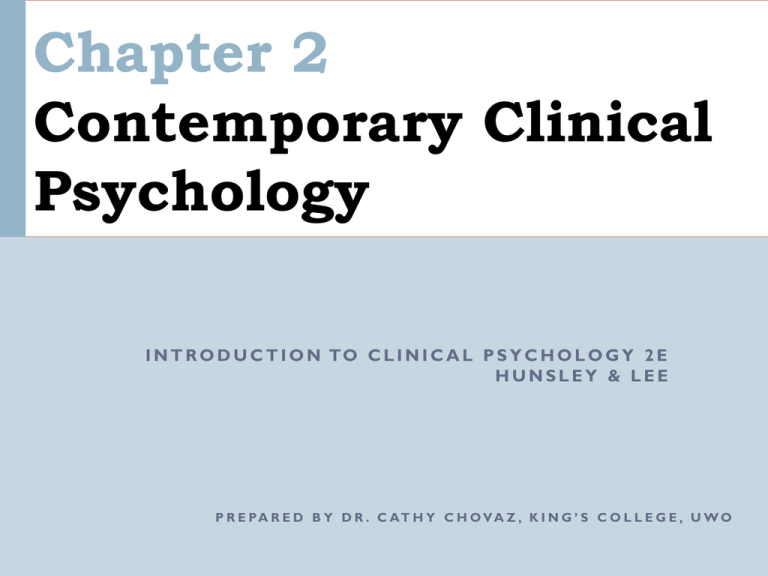
Chapter 2
Contemporary Clinical
Psychology
I N T R O D U C T I O N TO C L I N I C A L P S Y C H O L O G Y 2 E
HUNSLEY & LEE
P R E P A R E D B Y D R . C AT H Y C H O V A Z , K I N G ’ S C O L L E G E , U W O
Contemporary Clinical
Psychology
Activities
Two Pillars
Assessment & Diagnosis
Intervention
Prevention
Consultation
Research
Teaching
Supervision: Clinical &
Research
Administration
Science
Ethics
Activities of Clinical Psychologists
Clinical psychologists do a variety of activities including:
providing psychological assessment
providing psychological intervention
conducting research
providing clinical training
consulting with other professionals and agencies
Clinical psychologists work with
Individuals, couples, families, groups and organizations
All across the life span
Activities of Clinical Psychologists
Percentage of professional activities of Canadian clinical
psychologists
Assessment
Intervention
Consultation
Research
Teaching
Other
30.5
36.6
12.9
4.6
7.7
7.7
Adapted from Cohen, Hunsley, Westmacott, & Flear (2008).
Activities of Assessment &
Diagnosis in Clinical Psychology
Assessment is very common and comes in many forms
Evaluating the functioning of an individual client
Evaluating a family or social unit of some sort
Diagnosis
Formal standardized testing (cognitive, behavioral or
personality)
Assessment in psychotherapy
Planning
Monitoring
Evaluating
Activities of Intervention in
Clinical Psychology
Intervention is offered by the majority of clinical
psychologists.
Psychotherapy: talk therapy
Most people attend fewer than 10 sessions regardless of problem
Different approaches (psychodynamic, cognitive-behavioral,
experiential, etc) focus on different issues, (although most challenge
thoughts and validate emotions)
Most popular theoretical orientations in Canada is cognitive
behavioural (84%) followed by an interpersonal approach (28%) and a
psychodynamic approach (24%)
Intervention in Clinical
Psychology (cont.)
The Prescription Privileges Debate
Highly debated
Strong support from CPA section – Psychopharmacology
Canada’s publicly-funded health care system means federal
government has concerns about increasing number of
practitioners eligible to prescribe expensive pharmacological
treatments
Activities of Prevention in
Clinical Psychology
Prevention is less common but growing
Primary prevention: prevention of a disease before it occurs
Secondary prevention: reducing the recurrence of a disease
Tertiary prevention: reducing the overall disability that results
from a disease
Prevention usually based in community settings
Psychologist usually has several roles in prevention
Developing programs
Implementing programs
Evaluating outcomes of programs
Additional Activities of
Clinical Psychologists
Consultation
Clinical consultation: offering advice and information for others
treatment professionals
Organizational (or community) consultation: evaluating a
service, or providing an opinion on how an organization is
doing
Usually there is a needs assessment, program development, program
evaluation, and policy consultation
Additional Activities of
Clinical Psychologists (cont.)
Research
All psychologists are trained to conduct and evaluate research
APA & CPA’s ethics code requires a commitment to increasing
scientific knowledge
Small percentage produce research
Much more common in university settings
Range and content of research varies dramatically
Can be on normal human functioning, psychopathology, assessment,
intervention or prevention
Additional Activities of
Clinical Psychologists (cont.)
Teaching
University courses (graduate or undergraduate) in variety of
areas related to clinical psych
Also can teach in several other settings (e.g., community
colleges, in clinics training professionals, to medical students, in
workshops/seminars etc.)
Clinical Supervision
Close monitoring of training clinicians
Done in an individual meeting or with a number of training
clinicians (group supervision)
Some supervisors have supervisees audio or videotape their
sessions
Additional Activities of
Clinical Psychologists (cont.)
Research Supervision
Assisting in the development and implementation of a research
study or program
Administration
organization, program development, meetings in committees
Two Pillars of Clinical
Psychology: Science & Ethics
1. Science of Clinical Psychology
Clinical psychologists must maintain their knowledge of
research relevant to their activities
This is true for all theoretical orientations
However, how research informs practice differs for many
clinical psychologists
Balance between open-mindedness and skepticism
Two Pillars of Clinical
Psychology: Science & Ethics
II. Ethics of Clinical Psychology
Canadian Code of Ethics – CPA (3rd edition)
Respect for the dignity of persons
Responsible caring
Integrity in relationships
Responsibility to society
Informed consent – all individuals in therapy and
participants in research must indicate that they
understand and are willing participants
Additional Aspects to Clinical
Psychology
Training in Clinical Psychology
Scientist-practitioner model (Boulder Model)
Clinical scientist model
Practitioner-scholar model (Vail Model)
CPA Accreditation in Clinical Psychology
Providing services that are competent for the larger
multicultural community
Additional Aspects to Clinical
Psychology
Licensure in Canada
Must meet minimal academic & clinical requirements
Required by law to provide ethical and competent services
In all provinces except Quebec and the Yukon must complete
supervision (1 year to 5 years)
Copyright
Copyright © 2010 John Wiley & Sons Canada, Ltd. All rights reserved.
Reproduction or translation of this work beyond that permitted by Access
Copyright (The Canadian Copyright Licensing Agency) is unlawful. Requests
for further information should be addressed to the Permissions Department,
John Wiley & Sons Canada, Ltd. The purchaser may make back-up copies for
his or her own use only and not for distribution or resale. The author and
the publisher assume no responsibility for errors, omissions, or damages
caused by the use of these programs or from the use of the information
contained herein.



